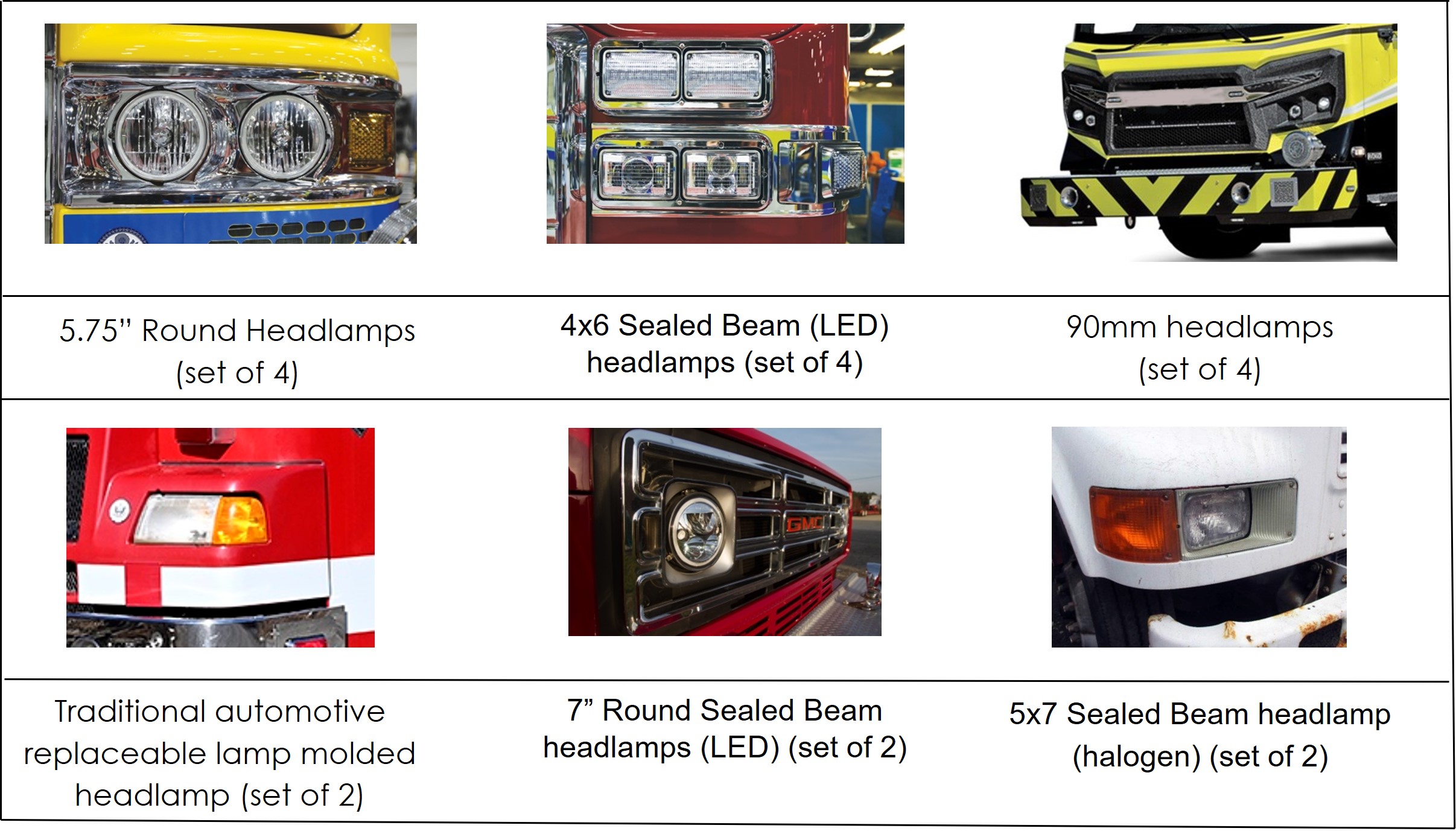Introduction
Every fire apparatus needs a set of headlamps. This guide describes headlamp technology and some key points fire departments should know when specifying, repairing, or upgrading fire apparatus headlamps.

Contents
Headlamp System Styles
There are two primary styles of headlamps used on fire apparatus.
MOLDED HOUSING REPLACEABLE BULB HEADLAMPS
A molded housing headlamp is a styled assembly where a polycarbonate or other clear plastic housing is used to protect the bulbs. These are more common in commercial chassis applications where the higher volumes will justify the expense of the special tooling required to create the housing. Each car or truck is styled with a unique housing and only the bulbs inside the housing are standardized. Rather than replacing the entire unit, only the bulb is replaced.

SEALED-BEAM UNIVERSAL HEADLAMPS
Standardized round or rectangular sealed beam incandescent lamps were once universal in the automotive industry. This is still the approach used for most custom fire apparatus. The two-lamp system (one per side) employs a lamp that has both the low and high beam functions integrated into each bulb. In the four-lamp system (two per side) the outer lamps provide either the low, or a combination of high and low beam function, and the inner lamps provide the high beam function. Some systems combine high beam and low beam functionality. When a sealed-beam bulb burns out, the entire lens unit is replaced.


REPLACEABLE BULB UNIVERSAL HEADLAMPS
Replaceable Bulb Universal Headlamps are typically the same size and shape as their Sealed Beam cousins, but they are designed with a replaceable bulb. When the bulb burns out it can be replaced without having to replace the entire lens.
COMMON CONFIGURATIONS
While the most common type of headlamp system on custom-cab fire apparatus today is a set of four 4 in. x 6 in. headlamps, numerous other configurations may be offered:

Headlamp Bulb Technologies
Each of the headlamp styles discussed above may be created using different types of bulb technology.
SEALED BEAM INCANDESCENT
These bulbs are simply a tungsten filament inside a vacuum. They may be found on old apparatus but are more or less obsolete in modern vehicles.
- Pros:
- Least expensive
- Generates sufficient heat to keep clear of ice or snow in most conditions
- Cons:
- Limited service life
- Poor illumination performance compared to modern technology
HALOGEN
Halogen bulbs are essentially an enhancement to the old incandescent bulb. Just like with incandescent light bulbs, the electrical current passes through a tungsten filament, heating up the filament to incandescence. The enhancement with halogen lamps is that the filament is enclosed in a quartz capsule filled with halogen gas. This gas is inert and made up of iodine and bromine. The gas allows the material that is naturally lost from the tungsten to be recycled back onto the filament, creating a brighter light and extending bulb life.
- Pros:
- Least expensive of the current technologies
- Generates sufficient heat to keep clear of ice or snow in most conditions
- Cons:
- Moderate illumination performance
- Moderate service life
HIGH INTENSITY DISCHARGE (HID)
HID headlights are arc lamps, like a neon sign. Instead of heating a filament to produce light, electricity arcs between two electrodes inside the bulb. HIDs are more efficient than halogen lamps, making more light with less energy. HID headlamps use a ballast and a very high voltage to create a very bright light. This type of headlamp assembly became popular on luxury automobiles in the late 1990’s and early 2000’s.
- Pros:
- Brighter and more favorable beam pattern over most halogen headlamps
- More energy efficient than halogen
- Higher color temperature (white light)
- Cons
- Complexity can lead to reliability issues
- Very expensive and not common auto-parts store replacements
- Often requires extra physical space for ballasts
LIGHT EMITTING DIODES (LED)
LEDs are the most modern headlamp source type on the market today. While LEDs have been around for a long time they were never bright enough to be used as a powerful light source. Leaps in LED technology has changed that, and they are now the preferred device for almost all lighting designs. LEDs have no moving parts, no filament, and often no glass to break.
- Pros:.
- Generally known for producing the best visibility
- Most reliable – some brands designed to last longer than the expected service life of the apparatus
- Maintenance free
- Cons:
- Properly designed FMVSS108 complaint LED headlamps are expensive
- Some brands do not produce enough heat to melt snow
- To provide longer life LED design must reduce output as temperature increases
Headlamp Enhancement Features
Higher-end automobiles may incorporate any number of fancy features such as wipers, hide-away housings or beams that change their aim with the steering wheel. While these features are not found currently on fire apparatus, there are some headlamp enhancements that may be available.
HALO RINGS
A halo ring is a lighting feature that surrounds the main lamps to provide an extra accent. The halo ring must be designed to stay compliant to FMVSS 108 and will have the following limitations:
- The lens code on the headlamp will designate what photometric classification the halo ring is operated under. “P” lens codes are the most common and indicate a “Parking” lamp function.
- Parking lamps must operate on the same circuit as the “marker” lights on the apparatus (first click of the headlamp switch).
- The color of the halo is limited by the classification of the lamp type. For “Parking” lamps facing forward on a vehicle, the only two acceptable colors are amber or white.
ICE AND SNOW HEATERS
Some LED headlamps do not produce enough heat naturally to melt ice or snow in inclement weather. Snow can accumulate on the headlamp lens which may limit effectiveness. Many headlamp manufacturers offer a heated version of their LED fixtures which are designed to improve effectiveness in cold snowy environments.
Daytime Running Lamps
Daytime Running Lamps (DRL) is a vehicle feature where the headlamps remain on even in the daytime. DRL is a requirement for all vehicles operating in Canada. Elsewhere in North America DRL systems are permitted but not required.
DRL systems should not be confused with the “Parking lamp” halos discussed above. There are 5 acceptable options that meet the requirements in FMVSS108 for a true DRL application:
- Low Beam Plus Markers – Operate the low beams plus all marker and clearance lamps
- Turn Signals Illuminated – Steady-light operation of front vehicle turn signals (except when one or the other of them is flashing as a turn signal)
- High Beam Partial Output – Operate the high beams at reduced output without other lights (subject to photometric requirement validation)
- Low Beam Partial Output – Operate the low beams at reduced output with ambient light sensor to kick to 100% when ambient is <1000 lux
- Dedicated DRL Lamps – Operate dedicated DRL lighting fixtures
Upgrading Technology on Old Apparatus
UNIVERSAL LENSES
A universal sealed beam or replaceable bulb lens is tested and certified as a unit. Old apparatus with universal lenses can be updated with same-size lens so long as the new units have proper DOT markings. Ensure that you are replacing each lens according to its application (low beam only, high beam only, or low/high beam combination).
UNIVERSAL INCANDESCENT OR HALOGEN TO HID
If making this upgrade, you must account for the extra space that the ballast will take. Departments considering this upgrade should consult with their apparatus manufacturer before proceeding. Re-wiring or special jumper cables will likely be required.
UNIVERSAL INCANDESCENT OR HALOGEN TO LED
An upgrade to LED in this case may require little more than simple rewiring. Consult with your apparatus manufacturer to ensure that you are getting certified DOT headlamps.
HALOGEN BULBS TO LED BULBS FOR MOLDED HOUSINGS
Molded housing lamps that came from the OEM should not be replaced with anything other than a replacement halogen bulb with the same wattage. While there are LED bulbs on the market that may fit in the housing and claim to be “DOT Approved”, the source type must never be changed without also changing the reflector and housing assembly as a part of the transition. LED lamps installed in housings which were designed and marked for other source types are not permitted for use on roadways in North America. A mismatched bulb and reflector have the potential to expose a fire department to liability in the event of a collision.
FOG LAMPS
When more light output is desired and a new headlamp module is not a viable option, consider installing a set of auxiliary driving or fog lights. These are often available in DOT compliant LED variants for relatively low cost.
Headlamp Assembly Certification
The federal standard governing all vehicle lighting can be found in the Code of Federal Regulations (CFR) Title 49 § 571.108 Standard No. 108; Lamps, reflective devices, and associated equipment. To conform with this standard, headlamps must be tested to a precise set of photometric requirements. The bulbs are not tested alone, rather the entire headlamp assembly is tested for conformity. Once the headlamp assembly passes, the manufacturer of the headlamp codes the lens with the appropriate data denoting the configuration. This is why it is essential that only the bulbs tested in the OEM configuration should be used as replacements. If a different wattage bulb, or a bulb of a different technology is substituted, the headlamp assembly no longer produces an identical photometric pattern, and therefore no longer matches the DOT coding that is permanently affixed to the lens or clear molded housing.
Counterfeit Headlamps
There are hundreds of vehicle lights for sale by on-line retailers. Many models of headlamps which are neither safe nor compliant for use on roads in north America are falsely advertised as “DOT APPROVED”. Others may lead you to believe they are appropriate for on-highway vehicles when they are actually only designed for off-road use. The words DOT do not mean that the US Department of Transportation has tested the lamps. It is up to the lamp manufacturer to test their products and mark them honestly.
A properly designed set of headlamps for use on the roadways must be designed so that light from the headlamps is sufficiently bright to illuminate the roadway, but more importantly, ensure light from the headlamp of your vehicle does present a hazard to other vehicles sharing the roadway. Just because the truck says “FIRE DEPARTMENT” it is not exempt from the law.
FAMA highly recommends that fire departments only replace headlamp assemblies with OEM replacement parts or consult with your apparatus manufacturer if you wish to upgrade an older apparatus.

